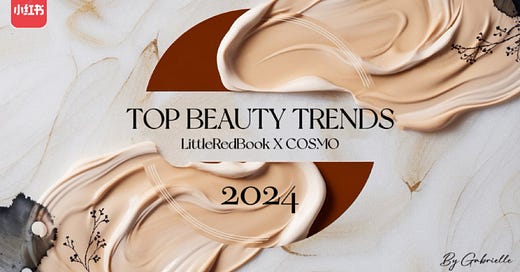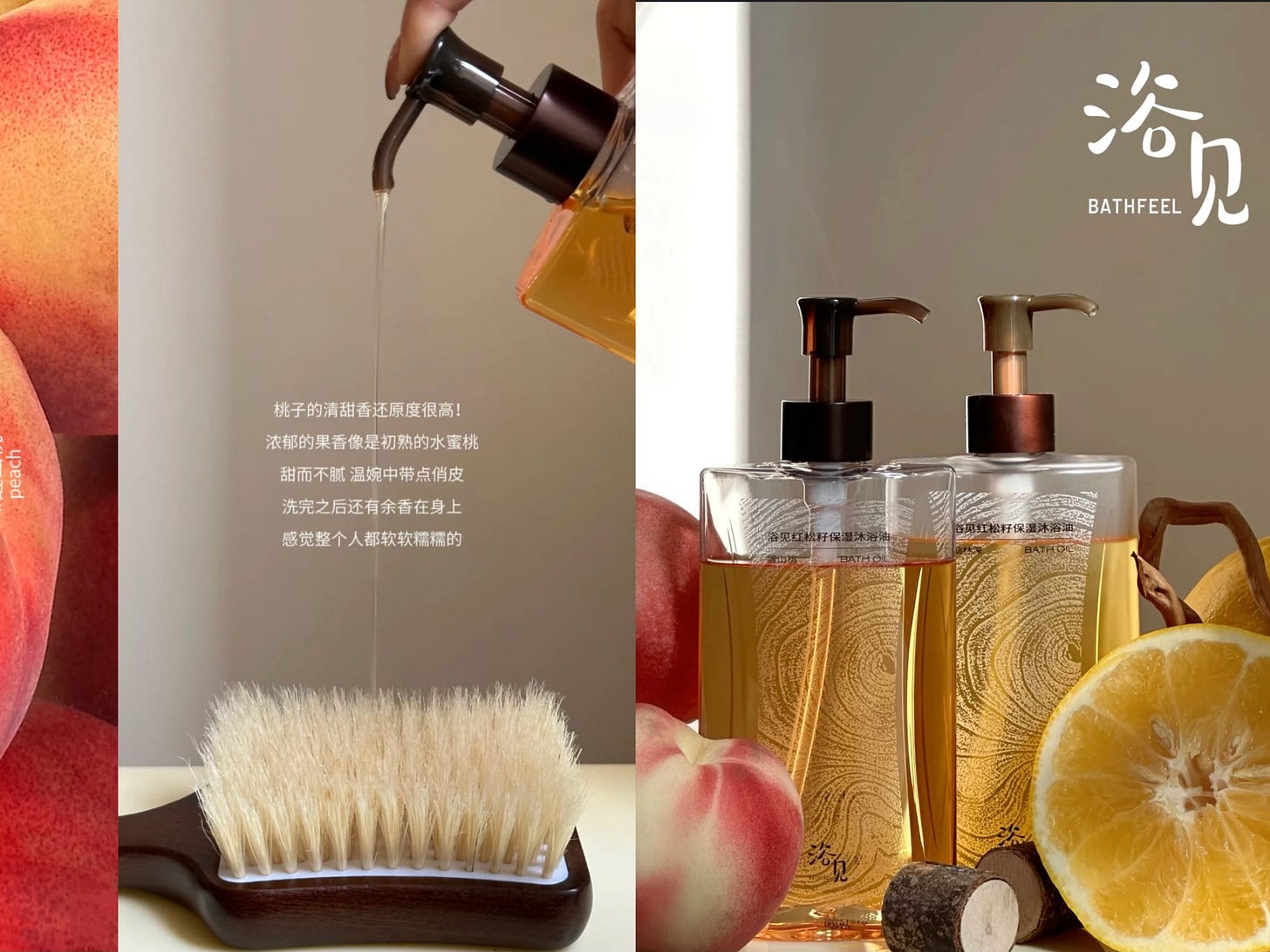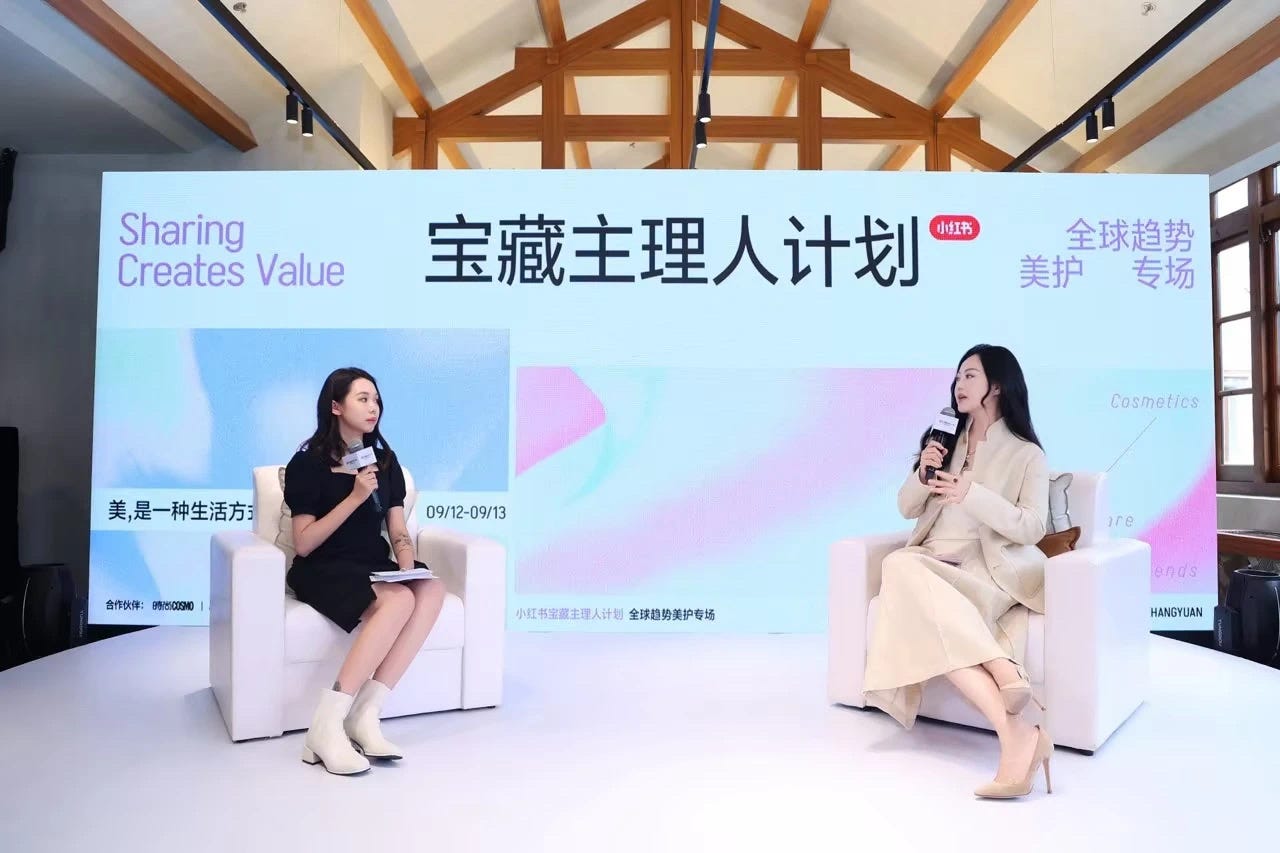Xiaohongshu Reveals: Top Beauty Trends in China for 2024
From Smart Splurges to Minimalist Skincare: How are China's Youth Redefining Beauty and Self-Care?
Hello, beauty lovers! Xiaohongshu (小红书, literally translated as "Little Red Book") and Cosmo have just released their latest 2024 Global Beauty Industry Trends Report1 based on data over the past 12 months, and it's quite revealing. With direct access to user data and behaviors, these trendsetters offer unparalleled insights into the evolving Chinese beauty landscape. Welcome to CHINA WHISPERS: Luxury & Beauty Insider, your trusted confidant to the ever-evolving world of luxury and beauty in the Middle Kingdom. Ready to scoop?
Why Xiaohongshu Matters
If you care about the Chinese market, then you can't ignore the social platform giant—Xiaohongshu. Think of it as China's equivalent to Instagram, but with broader topics and more varied content beyond photos and videos. It's more like a lifestyle guide and daily life encyclopedia, offering a unique blend of social sharing and practical information. The platform also boasts higher user stickiness, with average daily usage time 45% longer than Instagram2 . With 300 million monthly active users—70% female and 50% post-95, and half of them from first and second-tier cities—you can see why Xiaohongshu is essential for any brand looking to succeed in China3
“When in doubt, check Xiaohongshu” has become a mantra for China's youth, seamlessly woven into the fabric of daily decision-making. In fact, Xiaohongshu is even, to some extent, replacing Baidu (China's Google) as the go-to search engine for Gen Z and Millennials.
Event Highlights
On September 12-13, Xiaohongshu's e-commerce event, the Treasure Manager Global Beauty Trends Special Event, lit up Zhang Garden in Shanghai, a historic site built by a wealthy family in the 19th century, known for its significant cultural and architectural value. Who said beauty and history can't mix? Certainly not Xiaohongshu!
The event was a melting pot of beauty experts, brand founders, and buyers, all brainstorming how international beauty brands can make it big on Xiaohongshu. Xiaohongshu teamed up with Fashion COSMO to release the 2024 Global Beauty Industry Trends Report, based on data collected over the past year. Trust me, it's full of juicy insights. Let's dive into the goods!
*Unless otherwise noted, the following data are from the report 2024 Global Beauty Industry Trends Report, and covers the period from September 1, 2023, to August 31, 2024.
New Waves In Consumer Preferences
1. Rational Consumption on the Rise
Gone are the days of mindless splurging! Chinese consumers are becoming more budget-savvy, and the search for affordable alternatives is booming. We’re talking about 1.9 billion topic views and 130 million searches related to “affordable dupes” (平替), highlighting just how much consumers are seeking budget-friendly alternatives. People want great beauty products, but they want them without breaking the bank.
2. Ingredients and Functionality in the Spotlight
Skincare is no longer just about pretty packaging --- Chinese consumers are hyper-focused on what's inside the bottle. With 2.15+ million search for #tech-driven skincare(#科技护肤#), ingredients and scientific backing are all the rage. Brands, it's time to put on your lab coats and deliver smart, science-backed solutions.
3. Self-Indulgence in Personal Care
In a world where self-care is the new luxury, keywords like relaxation and healing are taking over personal care searches. But here’s the thing: Chinese consumers are quite different from their European counterparts. With long work hours, frequent overtime, and limited holidays, young people in China are often drained—physically and mentally.
Their jobs consume so much of their energy that they crave quick, convenient ways to relax and heal. That’s why concepts like “theurapeutic bathroom rituals” and “at-home hair salons” are soaring. People are turning their homes into mini retreats, giving themselves a much-needed break from the daily grind.
4. Lifestyle Scenarios Integration: A New Beauty Trend
By analyzing Xiaohongshu search data, we’ve identified a growing trend: consumers increasingly seek beauty products tailored to specific lifestyle scenarios. Over the past year, there's been a notable rise in interest for key words like commuter makeup and skincare for late nights or travel, signaling a need for brands to create products that fit seamlessly into these everyday moments.
In the upcoming 'Rising Subcategories' section, you'll explore 6 key beauty trends. Drawn from Xiaohongshu's past year data, these trends fit into real-life scenarios one way or another, offering beauty solutions that resonate with everyday lifestyles
Rising Subcategories to Embrace
1. Bold Color Artists
The thirst for creativity and artistry in makeup is real, with bold, colorful makeup becoming a new playground for consumers. For young people in China, makeup has transformed into a fun, energizing hobby— instead of simply applying makeup, it's more like playing with make-up, a form of entertainment allowing them to experiment and express themselves more freely.
2. Great Beauty on a Small Budget
Affordable international makeup brands are having their moment, with 40,000 posts related to affordable alternatives and budget-friendly options. People want to look fab without spending a fortune. And it’s not just about “affordable dupes"—there are other related trending keywords that can spark new ideas for product managers even if your prices are not that accessible after all. Borrowing from a popular Chinese meme, it's like talking about everything except saving money, yet it's all about saving money. Some of these keywords include: #OnePaletteForHighlightAndContour (#高光修容一盘搞定#), #MultiUsePalette (#一盘多用#; #多功能彩妆盘#). Young consumers these days are sharp—if one palette does it all, isn’t that just another way to say discount?
3. Smart Skincare
Consumers' demand for high-tech skincare products is on the rise, with intelligent and science-driven solutions becoming a core market trend. Chinese consumers are exceptionally knowledgeable about complex active ingredients, actively seeking to match specific skin concerns with appropriate chemical compounds. They pay close attention to even minor ingredients, demonstrating a keen eye for detail in product formulations.
The report presents a top-3 ranking for each mainstream ingredient category. In the amine family, niacinamide is the crowd-pleaser everyone's crushing on. Hyaluronic acid is the rockstar of the acid gang. And in the alcohol realm? Retinol wears the crown. It's worth noting that engaging Chinese consumers requires a strong foundation in ingredient technology and efficacy. That being said, don't even think about approaching Chinese consumers without some serious ingredient game – they're not easily impressed by anything less than cutting-edge formulations.
4. Minimalism
Less is more! Streamlined routines with multi-functional, one-and-done products are stealing the show. Keywords like “streamlined skincare” (精简护肤) and “lazy skincare” (懒人护肤) have surged in popularity, with search volumes reaching 9.16 million. Marie Kondo would be proud.
The graph below shows the trend in 'Minimalist Skincare' topic views over the past 12 months. We observed a sharp upward trend starting around Double 11, reaching the first peak during Double 12 in 2023, followed by subsequent surges in interest that align with other major promotional events throughout the year. As a note, Double 11 and Double 12 are two key e-commerce promotional festivals in China. Double 11 takes place on November 11th, while Double 12 is held on December 12th.
5. Therapeutic bathrooms
As discussed earlier, the bathroom has become the new Zen garden, with "healing bath rituals" being searched 1.31 million times. One Chinese brand to watch is BATHFEEL (浴见), a rising star in China's beauty scene, handpicked by Xiaohongshu in this report as the ultimate bathroom healing product. Their Red Pine Seed Bath Oil and Ebony Bath Brush combo saw peak sales of over 5 million RMB(€635K) in a single month on Xiaohongshu.
Adding another feather to its cap, BATHFEEL made quite a splash during the 2024 "618" shopping extravaganza, a mid-year e-commerce event on June 18th, where Chinese e-commerce platforms offer significant discounts, attracting millions of consumers for large-scale sales. BATHFEEL bubbled up to the Top 3 in Tmall's bath oil category sales, rubbing shoulders with international seasoned favorites L'Occitane and Bioderma.4. Founded in 2015, BATHFEEL blends Oriental aesthetics with plant-based elements, creating a soothing experience rooted in the tranquility of “Eastern trees.”
This example highlights how brands can tap into the growing demand for relaxing, at-home spa experiences, proving that consumers want to transform their bathrooms into personal sanctuaries.
6. Home Hair Spa
Consumers are embracing pro-level haircare at home, with over 100 million searches related to at-home haircare discussions. It’s also a call back to the affordable dupes, giving consumers a chance to recreate an exquisite luxury spa experience at home.
Digital Transformation
Xiaohongshu isn’t just where you discover beauty—it’s where people buy it too. With over 40 million users purchasing beauty and personal care products on the platform in a year, we’re talking about a full content-to-cart journey. One of Xiaohongshu’s key strengths compared to other e-commerce platforms is its community-driven ecosystem. Through the Treasure Hunters and Treasure Managers model (买手和主理人模式), it has developed a content-born, sales-grown loop, creating a seamless journey from content discovery to purchase.
From a conversion funnel perspective, this kind of closed-loop system is vital for brands. It ensures that consumers are engaged at every step of their journey, from initial inspiration to final purchase, making it easier to capture and convert potential buyers. While Western platforms like Instagram and TikTok are also striving to build similar content-to-sales ecosystems, the more mature, integrated nature of Xiaohongshu’s model offers brands a unique opportunity to leverage the Chinese market’s preferences.
Treasure Managers: Xiaohongshu's Influencer Revolution
Xiaohongshu is revolutionizing the influencer marketing landscape with its innovative "Treasure Manager Program"(宝藏主理人计划). This initiative goes beyond traditional key opinion leader (KOL) collaborations, creating a new breed of content creators who blend personal vision with deep product knowledge and authentic engagement. By empowering these "Treasure Managers," Xiaohongshu is not just facilitating brand exposure but driving substantial sales and reshaping consumer behavior.
A perfect example is Terasa Cheung(Xiaohui Zhang 章小蕙), one of the program's top treasure managers. During the 618 shopping festival, her curated selections generated over 10 million RMB (€1.27 million) in sales, with a 100% sell-out rate for each session. It’s all about building that connection with consumers and turning “I want it” into “I bought it!”
The culture and the term of 'curator (主理人)' originally comes from the American streetwear community, where it referred to the person in charge of a fashion brand, often the founder or a key member. For a long time, it was used exclusively within streetwear circles. However, in July this year, after insightful research, Xiaohongshu creatively extended the term to its platform content creators, launching the 'Hello, Treasure Manager' (你好,主理人) initiative. The translation shift from 'curator' to 'Treasure Manager' better reflects Xiaohongshu’s focus on content discovery and curation. Then in September, it introduced the 'Treasure Manager' program (宝藏主理人计划) during this event, aiming to strongly support content creators who embody the Treasure Manager spirit.
On Xiaohongshu, Treasure Managers are not your typical business owners or entrepreneurs in the traditional sense. Instead, they are individuals who develop or select products that reflect their unique personal vision. They know their products inside out and are deeply involved in every aspect of the business. Whether it’s writing posts, shooting videos, or live streaming, they are closely engaged in the process, showcasing both the products and the philosophy behind them. 5
The role of a Treasure Manager on Xiaohongshu is diverse and expansive. It's not limited to brand founders or owners—it can also include those responsible for the brand's operations, marketing, and overall direction after the brand's inception,These individuals play a crucial role in ensuring the brand's vision and strategy stay on track, maintaining the unique perspective that sets the brand apart in the marketplace.
This sets Xiaohongshu's creators apart from influencers or livestreamers on other platforms like Douyin (the Chinese version of TikTok) or Taobao, distancing themselves from the often negative connotations of "influencers" in the Chinese market. It also reinforces Xiaohongshu's mission of shaping lifestyle trends, making the platform's approach to modern living more tangible.
As an interesting side note that provides context to this phenomenon: Despite the glamorous facade, the term "influencer" (Wanghong 网红: internet celebrity) often carries a stigma in China, associated with attention-seeking behavior, superfacial image, fleeting fame and questionable product endorsements. This sentiment is so pervasive that even top performers in the field shy away from the label.
Take Yuhui Dong (董宇辉), for instance—a Douyin superstar with 23 million followers, known for his scholarly charm and wit. He may not have the most followers on Douyin, but his superpower lies in his livestream conversion ability. His influence is undeniable, having generated over 100 million RMB (12.8 million Euros) in sales during a single night of the 618 shopping festival on Douyin. Despite his success, Dong publicly expressed his disdain for being called a 'Wanghong' (influencer), during the Douyin show 'I Love Myself, I’m Great' (我爱我,很棒)on June 9, 2024. His remarks sparked a viral discussion, with the hashtag #YuhuiDongHatesToBeCalledInfluencer garnering 120 million views on Weibo (as of the time of writing). This widespread reaction underscores the complex relationship between content creators and their public perception in China's digital landscape.6
Conclusion
This report doesn’t just reveal the current Chinese market trends in the beauty sector—it highlights key industry movements in the Chinese market. Consumers' shift towards rational spending, their demand for personalized and functional products, and the pivotal role of digital platforms in shopping decisions are all reshaping how brands should approach their products and marketing strategies.
For brands, the big question is: How do you stand out in such a rapidly evolving market? Should you focus more on niche segments and emerging consumer needs? And how should your digital strategy adapt to these new trends? These are crucial questions that brands must deeply consider moving forward, and that we will continue exploring in this Substack.
Take-away for Brands
Alright brands, here’s what you need to take away:
1. Innovate with New Categories: From minimalist skincare to at-home haircare, align with the latest trends and offer products that seamlessly fit into daily life, giving consumers solutions they didn’t know they needed.
2. Ride the Rational Wave: As budget-savvy consumers seek value, high-end brands can offer smart alternatives like value sets or multi-functional products to meet their needs.
3. Go all-in on digital: Leverage Xiaohongshu’s strong content-to-commerce ecosystem, along with other platforms like Douyin, which fast-track users from discovery to purchase by seamlessly integrating content and commerce.
4. Leverage Treasure Managers: Collaborate with Treasure Managers to fast-track sales and build deeper connections. These creators act as trusted product experts and trendsetters. Even better, you can create your own unique Treasure Manager IP for your brand to engage consumers on a deeper level.
Stay tuned for more insider tips and trends on marketing in China, right here on my blog!
Average Daily Usage Time in 2023:
Xiaohongshu: 55 mins, sourced from DIGITALING
Instagram: 30 mins sourced from eMarketer











Very interesting insights! Hard to imagine that top influencers feel offended to be called influencers😂 LOL